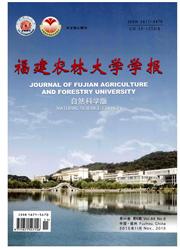

 中文摘要:
中文摘要:
采用XRY-1A数显氧弹式热量计测定该群落不同层次共18种优势植物不同器官的热值.东山岛季风常绿阔叶林优势种的平均干重热值介于14.95—18.7610·g-1之间,乔木层植物干重热值以潺稿树最高(18.76kJ·g-1),朴最低(17.53kJ·g-1);灌木层植物以豺皮樟最高(16.42kJ·g-1),露兜树最低(15.16kJ·g-1);草本层植物干重热值在14.29—14.78kJ·g-1之间;层间植物以帘子藤最高,雀梅藤最低.各层优势植物平均干重热值和去灰分热值表现为;乔木层〉层间植物〉灌木层〉草本层.植物器官间去灰分热值存在差异,乔木层和灌木层表现为叶〉干或枝〉根,草本层和层间植物为地上部分〉地下部分.本研究表明,气候条件和土壤类型是造成东山岛季风常绿阔叶林优势植物热值较低的主要原因.
 英文摘要:
英文摘要:
The caloric values were measured by the XRY-1A oxygenic bomb calorie-meter. The results were as follows. The mean gross caloric values (GCV) of the 18 dominant species were in the range of 14.95 -18.76 kJ· g-1. Litsea glutinosa (18.76 kJ · g-l) was the highest and Celtis tetrandra subsp, sinensis (17.53 kJ · g-1) was the lowest GCV species in the tree layer, while the corresponding species were Litsea rotundifolia vat. oblongifol ( 16.42 kJ·g-1 ) and Pandanus tectorius ( 15.16 kJ ·g-1 ) in the shrub layer . The mean GCV of four herbaceous species was in the range of 14.29 - 14.28 kJ · g-l. In the liana layer, the highest GCV species was Sageretia thea and Pottsia laxiflora was lowest. The GCV and ash free calorie values (AFCV) decreased in the following order: tree layer 〉 liana layer 〉 shrub layer 〉 herbaceous layer. The AFCV was different among different organs. In the tree layer and shrub layer, the AFCV decreased from the leaves, stems or branchs to roots. In the liana layer and herbaceous layer, aboveground 〉 underground. Our analysis showed that climate condition and soil type were the main reasons resulted in the lower caloric values of dominant species from monsoon evergreen broad-leaved forest of Dongshan Island.
 同期刊论文项目
同期刊论文项目
 同项目期刊论文
同项目期刊论文
 期刊信息
期刊信息
